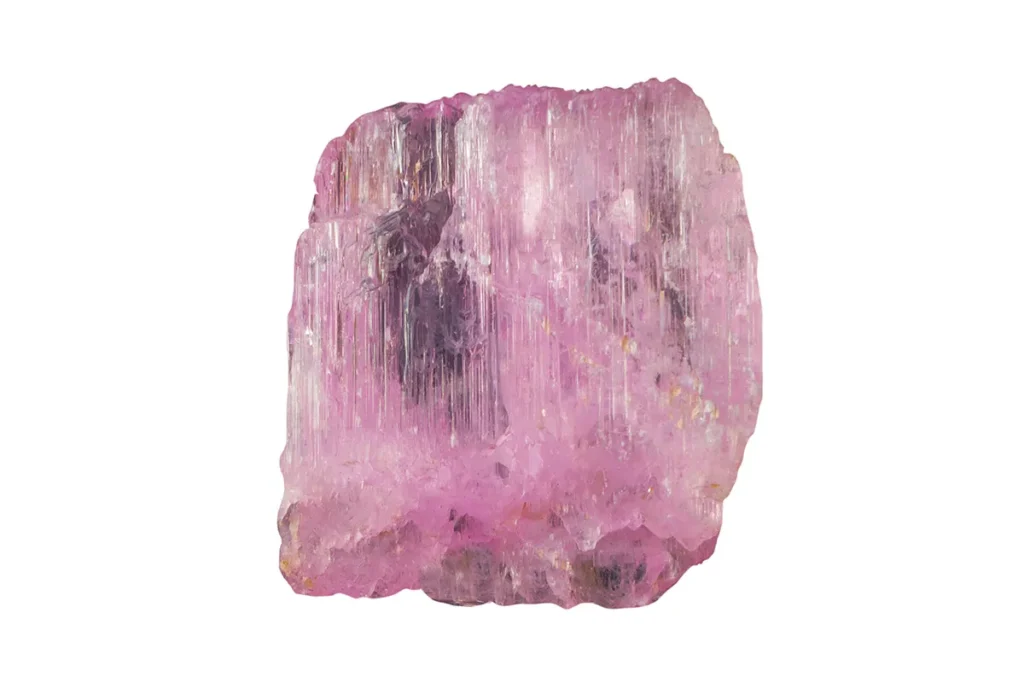
Appearance
The delicate and soft pink to lavender hues of kunzite are well known. Pale pink, lilac, and light violet to more intense colors of pink can be found within the color spectrum. Being able to display multiple colors depending on the angle at which it is seen makes it one of the rare gemstones that exhibits pleochroism. Kunzite’s crystal structure is made up of three uneven axes that connect at oblique angles, or a monoclinic crystal system. When cut as a gemstone, kunzite’s elongated crystal structure adds to its distinctive prismatic or elongated shape.
Geographical Distribution
Kunzite can be found in a variety of geological conditions. Pegmatite deposits, which are created as magma cools and crystallizes, are where it is typically mined. Particular areas with deposits of Kunzite include the United States of America’s California, Brazil, Madagascar, Afghanistan, Myanmar, and other countries.
History
Early in the 20th century, in 1902, renowned gemologist and mineralogist George Frederick Kunz made the first discovery of kunzite. It was first discovered in San Diego County, California, USA’s Pala area. When kunzite was first discovered, it was frequently confused with other pink gemstones like morganite or rose quartz.
The first name for the earliest Kunzite specimens was “Pink Spodumene.” Nevertheless, the gemstone was subsequently given the formal name “Kunzite” in George Kunz’s honor in recognition of his contributions to gemology as well as his part in finding and publicizing the stone.
The popularity of the gemstone increased gradually over time, especially in the 1920s and 1930s during the Art Deco era, when light-colored gemstones were quite in. Because of its delicate pink to lavender hues, kunzite became a highly sought-after gemstone for jewelry designs, perfectly matching the aesthetic inclinations of that era.
Metaphysical Properties
Kunzite is a joyful stone that promotes communication between the heart and the mind by opening and connecting them. It is said that wearing kunzite enhances your capacity to both receive and give love. Kunzite is also thought to ease anxiety and soothe broken hearts.

Chemical Composition
One type of spodumene mineral that is a member of the pyroxene group is kunzite. Lithium aluminum silicate makes up its chemical constitution (LiAlSi2O6). The pink to lavender hue of the gemstone is caused by the presence of lithium.
Types
A few notable types are as follows:
The Pink Star:
One of the largest known Kunzite gemstones is the Pink Star, sometimes referred to as the Steinmetz Pink. This oval-shaped fancy vivid pink Kunzite weighs 59.60 carats and is well-known for its rich and lively color.
The American Golden:
At 14.85 carats, the American Golden is a spectacular Kunzite gemstone. In the early 1900s, when Kunzite was beginning to acquire popularity, it was found in San Diego County, California.
The Pink Lotus:
One famous Kunzite gemstone that can be found in the Smithsonian National Museum of Natural History’s collection in Washington, D.C. is the Pink Lotus. Known for its exquisite soft pink hue, this 82-carat Kunzite is thought to be among the finest and largest gemstones available for public viewing.
Uses
The following are some typical applications and uses for kunzite:
- Jewelry: Kunzite is frequently used in jewelry, especially in bracelets, earrings, pendants, and rings. Its soft pink to lavender hue makes it a desirable option for romantic and feminine themes. Gemstones made of kunzite are frequently faceted to increase their luster and brilliance.
- Center Stones: In engagement rings and other statement jewelry, kunzite can be set as the center stone. Its distinctive coloring and pastel tones can produce striking and elegant works.
- Accent Stones: In addition, kunzite is utilized as an accent stone when paired with other gemstones like white topaz, amethyst, or diamonds. These pairings can result in jewelry creations that are gorgeous and eye-catching.
- Cabochons: Apart from being cut into faceted gemstones, kunzite is also occasionally carved into round, smooth cabochons. The warm, radiant appearance of cabochon-cut kunzite is highly valued in jewelry designs.
- Carvings and Sculptures: Kunzite is occasionally used for carvings and sculptures because of its appealing color and quite high toughness. With Kunzite, skilled craftspeople can make elaborate and detailed designs, such as ornamental objects or animal figures.
- Collectibles: Since kunzite is rare and has special qualities, collectors of gemstones are drawn to it. Kunzite specimens with remarkable color, clarity, and size are highly prized by collectors.
Table





